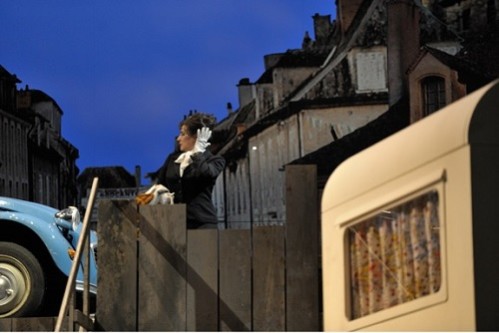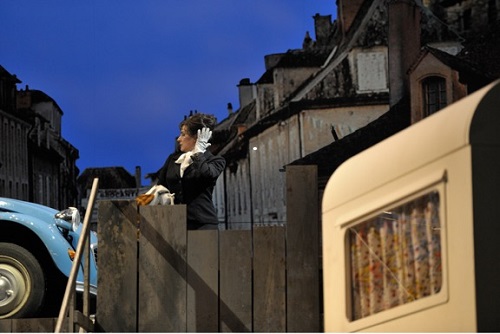 Switzerland Rossini, Le Comte Ory: La Scintilla, Chorus (and extra chorus) of Zurich Opera, 12.3.2016. (JR)
Switzerland Rossini, Le Comte Ory: La Scintilla, Chorus (and extra chorus) of Zurich Opera, 12.3.2016. (JR)

Cast:
Countess Adèle – Cecilia Bartoli
Isolier – Rebeca Olvera
Ragonde – Liliana Nikiteanu
Alice – Claire de Sévigné
Count Ory – Edgardo Rocha
Raimbaud – Oliver Widmer
Tutor – Roberto Lorenzi
Gérard – Iain Milne
Mainfroy – David Margulis
A peasant – Henri Bernard
Coryphées – Estelle Poscio, Lin Shi, Pavel Petrov, Ivan Thirion, Adrian Timpau
Production:
Conductor – Jean-Christophe Spinosi
Producers – Moshe Leiser, Patrice Caurier
Scenic director – Claudia Blersch
Set – Christian Fenouillat
Costumes – Agostino Cavalca
Lighting – Christophe Forey, Martin Gebhardt
Chorus masters – Jürg Hämmerli
Dramaturgy – Michael Küster
The plot of Rossini’s comic opera Le Comte Ory is simply told. It is all supposed to take place at the time of the Crusades (around 1200) and many of the fit and able noble menfolk of a small French provincial town have gone off to fight. Count Ory, in love with the local Countess, takes advantage of the situation by disguising himself as a hermit and acting the charlatan. He succeeds in Act I in seducing many of the local womenfolk who are duped by his appearance. There’s a problem, however: Ory’s page, Isolier (a trouser role, sung by a mezzo soprano) is also in love with the Countess. Isolier tells his master, Ory, that he plans to sneak into the castle dressed as a female pilgrim to gain the Countess’s affections.
In Act 2 Ory and his merry band of men seize on Isolier’s plan and beat him to it. During a ferocious storm, they beg for shelter and gain access to the castle dressed as nuns. Isolier recognises Ory and plots his farcical comeuppance in what turns out to be an entertaining bedroom scene. He is unmasked, the women’s’ husbands return from the war and Ory escapes, angrily, from the castle.
The opera is rarely performed. Some of the music originates from Rossini’s earlier opera Il Viaggio à Reims. The Met premièred the opera a few years ago with Flórez, Damrau and DiDonato, and revived the production a few years later. Zurich Opera premièred it at about the same time, with Cecilia Bartoli as the Countess and Javier Camarena as the Count, under the baton of Muhai Tang. It was a roaring success, so no hesitation in reviving it. Bartoli returns, Camarena replaced by young Uruguayan tenor Edgardo Rocha.
The “show”, for it is a show, is a success on two counts: Bartoli for her precise mastery of the many coloratura passages, and Leiser and Caurier for a witty, pretty production.
Moshe Leiser and Patrice Caurier have been an inseparable production team since the 1980s and only work with the same team of set designer, costume designer and even lighting engineer. They have updated the Crusades to the end of the Algerian War of Independence, 1962. This gives the costume designer scope for some wonderfully psychedelic and colourful 60s clothes and patterns. Ory hides in an old caravan, his tutor arrives in an old Jeep, the Countess in a 2CV. The Castle’s drawing room is a homage to the Sixties, complete with black and white television. There is much to enjoy visually, the production team have great fun exploding light bulbs in the storm scene.
There is much to enjoy vocally, too. Bartoli clearly relishes the role and can employ her coloratura and acting skills to the full. I must say I preferred Camarena to Rocha as Count Ory, but Camarena is now much in demand at the Met. Camarena acted the role with more sleaze factor and his top Cs rang out, but Rocha also gets there with apparent ease and certainly acts well enough.
Rebeca Olvera returns to the role of Isolier with vocal and thespian aplomb. Prize however for best actor (and costume) goes to Liliana Nikiteanu repeating the role of Ragonde, her warm mezzo impressed. Bartoli’s real-life husband Oliver Widmer was on stage as Raimbaud and enjoyed his rollicking drinking song as much as we did. Roberto Lorenzi, as the tutor, plumbed the very depths of the bass register to great effect. Claire de Sévigné showed promise with her delicate and precise soprano as the peasant girl, Alice.
In the pit, Corsican Jean-Christophe Spinosi. Humour was evident from the outset in the rather disjointed Overture; Spinosi had a joie de vivre and verve which complemented the opera perfectly. Zurich Opera’s period orchestra, La Scintilla, was raised up slightly, into the auditorium, for greater clarity of sound. It has to be said that not everyone likes the occasionally scrawny sounds which period orchestras are prone to produce, but after a very short while one became attuned to the crispness of the authentic sound. The players followed Spinosi’s exacting signals with precision and with evident enjoyment, turning round whenever possible to watch the antics on stage.
In short then, a great show and an enjoyable romp. I had a smile on my face throughout. The performance was followed by some of the longest applause I have heard at Zurich’s Opera for some while – which says it all.
John Rhodes
